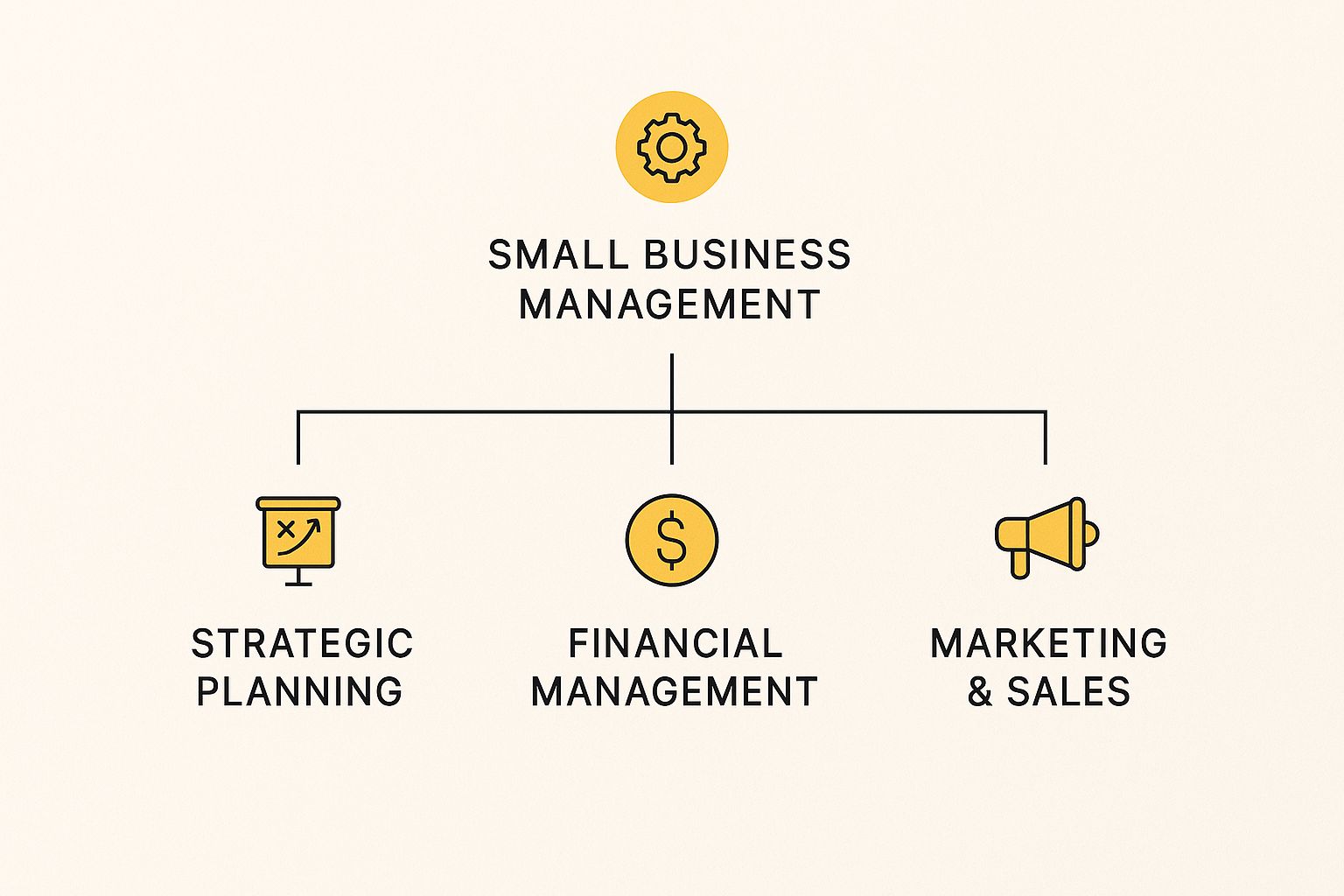When you're running a small business, "management" isn't just a fancy title—it's the art of spinning a dozen plates at once to keep everything moving forward. It means you're the strategist, the accountant, the marketer, and the team leader, all rolled into one, guiding your business towards real, sustainable growth.
Getting Your Head Around the Basics of Small Business Management
Think of yourself as the captain of a ship. It’s not just about steering; you’re also in charge of the crew, the engine room, and making sure there are enough supplies to get to your destination. Every single decision—from charting the course (your strategy) to managing the fuel (your finances)—determines whether you sail smoothly or hit a storm.
Getting this right is a massive deal, especially when you realise that small businesses are the absolute backbone of our local economy. In fact, an incredible 97.2% of all businesses in Australia are small, and most of them have fewer than 20 employees. This really puts into perspective how much of a collective impact individual owners like you have when you get your operations humming. You can dive deeper into the numbers with the official factsheet on small business from the Australian government.
The Core Pillars of Management
To really get a handle on this, you need to focus on a few key areas that all work together. Let one slide, and the whole thing can start to feel wobbly. It’s like having a great map for your ship but ignoring a leaky hull. These pillars give you a solid framework to build on, making sure nothing critical gets missed.
This diagram breaks down the fundamental parts that branch out from the main idea of management.

As you can see, things like your big-picture strategy, keeping a tight rein on the finances, and getting your marketing right are the main supports holding up any successful small business.
A High-Level Map for Your Journey
Wearing all those different hats is just part of the gig for most owners. One minute you're the visionary, dreaming up the five-year plan; the next, you're hunched over invoices, playing bookkeeper. The real trick is knowing which hat to put on and when.
Juggling these roles is the true challenge—and the real reward—of being an entrepreneur. It's all about building systems that let you jump from high-level strategy to on-the-ground tasks without losing your focus or momentum.
To help you picture how all this fits together, let’s lay out the main pillars we’ll be exploring in this guide. Think of this table as your high-level map, defining what each area is all about and how you can tell if you're on the right track.
| The Five Pillars of Small Business Management |
| :— | :— | :— |
| Management Pillar | Primary Objective | Key Success Metric |
| Strategic Planning | Set a clear vision and long-term direction for the business. | Achievement of major milestones and growth targets. |
| Financial Management | Maintain profitability and ensure financial stability. | Positive cash flow and healthy profit margins. |
| Operations Management | Optimise day-to-day processes for maximum efficiency. | Reduced operational costs and faster delivery times. |
| Human Resources | Build and maintain a productive and motivated team. | High employee retention and positive team morale. |
| Marketing & Sales | Attract and retain a loyal customer base. | Consistent lead generation and customer acquisition. |
This table gives you a starting point—a clear snapshot of what to aim for as you begin your journey into mastering small business management.
Creating Your Strategic Business Roadmap
Ever heard someone say a business plan is just a stuffy document for the bank? Let's chuck that idea out the window. A great business plan is your business's GPS—a living, breathing guide that steers your daily decisions and keeps everyone heading in the same direction. Solid small business management is all about turning that plan from a one-off chore into a practical, everyday tool.
Think about it: you wouldn't set off on a massive road trip without a map, would you? Your business plan is that map. It shows you where you're going, the best routes to get there, and even warns you about a few tricky intersections you might hit along the way. It’s a tool for being proactive, not just a formality. This roadmap makes sure every move you make, from hiring a new team member to launching a marketing campaign, actually lines up with your big-picture vision.
Setting Goals That Actually Work
The heart of any good roadmap is clarity, and that starts with setting goals that have some real teeth. It's easy to come up with vague ideas like "increase sales," but to get real results, you need to use the SMART goal framework. This nifty method ensures your objectives are clear, motivating, and, most importantly, doable.
Each goal you set should be:
- Specific: Nail down exactly what you want to achieve. Instead of "improve marketing," a specific goal is "increase website traffic from organic search by 20%." See the difference?
- Measurable: You have to be able to track your progress. A 20% increase is a concrete number you can actually monitor.
- Achievable: Be honest with yourself. Is this goal realistic with the resources and time you have? A 500% increase in one month is probably just going to be demoralising, while 20% is a solid, challenging target.
- Relevant: Does this goal actually push your business forward? If you're trying to build a local brand, focusing all your energy on international shipping might not be the best use of your time right now.
- Time-bound: Give yourself a deadline. "Increase traffic by 20% within the next six months" creates a sense of urgency and a clear timeframe for getting it done.
When you frame your goals this way, you turn wishful thinking into a concrete action plan.
Figuring Out Where You Stand with a SWOT Analysis
Okay, so you've got your goals. Now, you need a clear picture of your starting point. This is where a SWOT analysis comes in—it’s a simple but incredibly powerful tool for getting your bearings. It helps you size up your situation by looking at four key areas. To really get your business moving, looking into proven small business growth strategies can also give you some great ideas to plug into your plan.
A SWOT analysis breaks down into:
- Strengths (Internal): What are you genuinely great at? This could be your killer coffee blend, your top-notch customer service, or your super-skilled team.
- Weaknesses (Internal): Where are the gaps? Maybe it’s a clunky website, a tiny marketing budget, or some messy internal processes that need a tidy-up.
- Opportunities (External): What's happening out there that you could jump on? A new farmers' market opening up is a golden opportunity for a local bakery to find new customers.
- Threats (External): What could trip you up? This might be a new competitor opening down the road, your supplier hiking up their prices, or a shift in what customers are looking for.
A SWOT analysis isn't about judging yourself; it's about being aware. Knowing your weaknesses is just as powerful as knowing your strengths because it tells you exactly where to put your energy to get better.
For instance, a small tech startup might identify its cutting-edge software as a Strength but admit its low brand recognition is a big Weakness. An Opportunity could be a new government grant for tech businesses, while a Threat might be a huge competitor launching a similar product. This simple exercise gives you the crucial insights you need to navigate the road ahead and build a business that can handle whatever comes its way.
Taking Control of Your Business Finances
Too many great business ideas fall flat, not from a lack of customers, but because the financial foundations just aren't there. Proper small business management is all about getting a firm grip on your numbers. Think of your business finances like the dashboard of your car—it’s got all the gauges you need to keep things moving safely and efficiently.
If you don't know how to read those gauges, you're essentially driving blind. The first step is learning to understand your financial statements. These aren't just stuffy documents for your accountant; they're vital tools telling the story of your business's health, helping you make smarter decisions every single day.

Reading Your Financial Dashboard
Your main financial "gauges" give you a clear snapshot of where your business stands. Don't let the terminology intimidate you; the concepts are actually pretty straightforward once you get the hang of them.
There are three key reports you need to get familiar with:
- Profit & Loss (P&L) Statement: This is basically your report card. It shows your total revenue minus all your expenses over a set period (like a month or a quarter) to reveal whether you actually made a profit or a loss.
- Cash Flow Forecast: Think of this as your fuel gauge. It predicts the cash coming in and going out of your business, helping you spot potential shortfalls before they become a real problem. No one wants to run on empty.
- Balance Sheet: This report gives you a snapshot of your business's overall financial health at a single point in time. It lists what you own (assets) and what you owe (liabilities), giving you a clear picture of your net worth.
Setting Up a Simple Bookkeeping System
Good financial management starts with clean, organised bookkeeping. You don't need a super complex or expensive system, especially when you're just starting out. The goal is simply to have a reliable record of every dollar that comes in and every dollar that goes out.
A non-negotiable first step is to separate your business and personal finances. Open a dedicated business bank account and use it for all business-related transactions. This isn't just a friendly suggestion—it’s essential for staying legally compliant, making tax time a breeze, and truly understanding how your business is performing.
Managing your finances well isn't just about tracking what you spend. It's about building a system that frees up your mental energy so you can focus on growing the business. The time you put in here pays you back in clarity and peace of mind.
To really get on top of your business finances, you need to know what tax deductions you can claim. It's worth checking out a detailed Australian Small Business Tax Deductions Guide to make sure you’re not leaving money on the table.
Smart Invoicing and Pricing Strategies
Getting paid on time is the lifeblood of any small business. A hiccup here can quickly turn into a cash flow crisis, even if sales are booming. Your invoicing process needs to be set up to encourage clients to pay you promptly.
Here are a few tips you can put into action straight away:
- Invoice Promptly: Send your invoices the moment the job is done or the product is delivered. The longer you wait, the longer you'll be waiting for your money.
- Clearly State Payment Terms: Make sure the due date, payment methods, and any late fees are crystal clear on every invoice. Simple terms like "Net 14" are pretty standard.
- Offer Multiple Payment Options: Make it as easy as possible for people to pay you. Accept bank transfers, credit cards, or whatever online payment platforms your customers use.
Finally, let's talk pricing. Your prices have a direct impact on your bottom line. Don't just copy your competitors. You need to calculate your costs properly—that includes materials, your own labour, and overheads—then add a profit margin that reflects the value you bring and helps your business grow. Nailing these financial tasks is a huge part of effective time management for small business owners, freeing you up to spend less time chasing payments and more time building your dream.
Building Efficient Day-To-Day Operations
Once your finances are on solid ground, it’s time to turn your attention to the engine room of your business: your day-to-day operations. This is where your grand strategy gets real. Crafting smooth, efficient workflows isn't about chasing some mythical idea of perfection; it's about building systems that save you precious time, slash costly errors, and consistently deliver a top-notch customer experience.
Think of your operations like the choreography of a stage play. When everyone knows their part and the timing is right, the performance is flawless. But if the processes are messy and inconsistent, the audience—your customers—will definitely notice. The goal here is to standardise your key activities so they run like clockwork, whether you're handling stock, talking to suppliers, or answering customer questions.
Standardising Processes for Consistent Quality
"Standardisation" might sound a bit corporate, but it's a simple idea with a massive payoff. It just means figuring out the single best way to do a recurring task and then making sure your team does it that way, every single time. You don't need fancy software for this; often, the simplest tools are the most effective.
For instance, a basic checklist for bringing on a new client ensures no steps are missed, from getting their details right to sending out a welcome email. It's this kind of consistency that builds trust and makes you look like a pro.
This image from the OnSilent website shows just how straightforward managing communications can be with the right setup.

The clean layout is a great example of how modern tools are designed to be intuitive, letting you handle complex tasks without a massive learning curve.
You can apply this organised approach to just about any part of your business. The result? Fewer mistakes, less time wasted fixing things, and a higher quality of service that keeps your customers coming back for more. It all comes down to small, consistent actions.
“Systemising your processes is the key to creating a business that can run without you, not because of you. It’s the difference between buying yourself a job and building a valuable asset.”
Using the Right Tools for the Job
Not so long ago, powerful business tools were only for the big players with deep pockets. Today, that's completely changed. There's a whole world of affordable, user-friendly tech designed specifically for small businesses, letting you punch well above your weight. Getting the right tech on your side is an absolute game-changer for efficiency.
The trick is to start small and zero in on your biggest headaches. Are you spending way too long tracking projects on a chaotic spreadsheet? Are your customer comms all over the place? I guarantee there's a simple tool that can help.
Here are a few types of tools that can make a huge difference right away:
- Unified Communications: Tools like OnSilent bring all your calls and messages into one organised hub. This stops vital client info from getting lost in a mess of missed calls and voicemails, so you can follow up quickly and professionally.
- Project Management Software: Platforms like Trello or Asana give you a visual way to track tasks, deadlines, and who’s doing what. They bring a heap of clarity to your workflow, which is a lifesaver for team projects.
- Customer Relationship Management (CRM): A simple CRM helps you keep track of all your customer interactions and data. It ensures you remember the little details about your clients, helping you build stronger, more personal relationships that create real loyalty.
Choosing new technology can feel a bit overwhelming, but many of these tools offer free plans, so you can try them out without any financial risk. By picking a few key pieces of software, you can seriously level up your daily operations. To get a better idea of how tech can lighten your load, check out this guide on small business automation tools. This is how you build a business that isn't just successful, but is also built to scale and last for the long haul.
Winning Customers with Modern Marketing
Let's be honest, trying to do your own marketing without a dedicated team can feel like you're just shouting into the wind. But a massive part of smart small business management is learning how to turn that shout into a real conversation. Modern marketing isn’t about throwing a huge budget at the wall and seeing what sticks; it’s about forging genuine connections and building a solid brand presence using clever, practical strategies.
The very first step? Get laser-focused on who you're actually talking to. Before you even think about a social media post or a flyer, you need to have a crystal-clear picture of your ideal customer. What headaches do they have that you can solve? What do they genuinely care about? Once you step into their world, you can craft your unique value proposition—a simple, punchy statement that makes it obvious why you're the best choice for them.

This clarity becomes the bedrock of everything you do in your marketing, making sure every single message hits home.
Building Your Digital Front Door
These days, your website is your digital storefront. It absolutely has to look professional, be a breeze to navigate, and spell out exactly what you do. But just having a website isn't the whole story—people need to find it. That’s where search engine optimisation (SEO) comes into play.
Don't let the acronym scare you. SEO is really just about making some straightforward tweaks to your website so it shows up higher on Google when people are searching for a business like yours.
- Use Relevant Keywords: Put yourself in your customer's shoes. What words would they type into Google? Weave these terms naturally through your website’s pages, headings, and descriptions.
- Create Helpful Content: A blog is an absolute goldmine for this. By regularly posting articles that answer common customer questions, you show you know your stuff and give Google more reasons to send people your way.
- Focus on Local Search: For most small businesses, local customers are everything. Make sure your business is listed on Google Maps and that your name, address, and phone number are identical everywhere online.
A huge piece of the modern marketing puzzle is getting your head around effective online reputation management for small businesses. A string of positive online reviews can do wonders for your credibility and your search rankings.
Connecting with Your Community
Social media gives you a direct line to your customers, letting you build a real community around your brand. The secret is to pick your platforms wisely—don't spread yourself thin trying to be everywhere at once. Work out where your ideal customers hang out online and put your energy there.
The most powerful marketing doesn't feel like marketing at all. It feels like a genuine conversation that builds trust and fosters loyalty, turning customers into your most passionate advocates.
And don't forget about email. Beyond the social buzz, email marketing is still one of the most powerful tools in your kit. It's your personal channel for nurturing leads, announcing new offers, and keeping customers coming back. Building an email list gives you a priceless asset that you actually own, completely independent of any social media algorithm changes.
Even when the economy gets a bit rocky, smart marketing helps businesses push through. Recent data shows Aussie small businesses have been surprisingly resilient, with sales growth averaging 4-5% year-on-year despite inflation, though this has slowed recently. Nurturing those direct customer connections is what keeps that momentum going. You can dig into more insights about Aussie small business sales volatility on xero.com.
At the end of the day, it all comes back to creating authentic connections. When you consistently deliver value and engage with your audience, you build the kind of word-of-mouth buzz that money just can't buy. And for any small business, that’s the most sustainable engine for growth you could ask for.
Future-Proofing Your Australian Business
Look, running a small business isn't just about managing today's to-do list; it’s about making sure you’re still around tomorrow. To stay ahead in the Aussie market, you need to be proactive. It's about adapting before you're forced to and building a business that can handle whatever gets thrown at it. This is what separates the businesses that truly thrive from the ones just getting by.
This goes way beyond just having a basic website. We’re talking about weaving technology into the very fabric of how you operate—making things more efficient, helping you make smarter decisions, and giving your customers a better experience. It's about using the right tools to solve real, everyday problems.
Embracing Technology and Automation
Technology isn't just for the big end of town anymore. For small businesses, it's a fundamental tool for staying nimble and competitive. Getting the right solutions in place can free up your most precious resource: your time. This means you can stop drowning in repetitive admin and start focusing on actually growing the business.
Even small, strategic changes can make a massive difference. For instance, why not explore some simple business process automation examples? You could set up systems to handle things like booking appointments or sending out routine follow-ups to clients. Automating these little tasks cuts down on human error and makes sure every customer gets a consistent, professional experience.
Focusing on Sustainability and Social Responsibility
Let's be honest, today's customers—especially here in Australia—care about where their money goes. They want to back businesses that share their values. This is where focusing on ESG (Environmental, Social, and Governance) principles stops being a "nice-to-have" and becomes a genuine competitive edge.
And it doesn't have to be complicated or break the bank. Take a local café, for example. They could future-proof their brand by:
- Sourcing ingredients locally to cut down their carbon footprint and support other local businesses.
- Switching to compostable packaging to keep waste out of landfill.
- Setting up a clear recycling program in their kitchen and front-of-house.
These are tangible actions that build a rock-solid reputation and attract loyal customers who appreciate a business that gives a damn.
Adapting to New Ways of Working
The old 9-to-5 grind in a stuffy office is on its way out. The move to remote and hybrid work isn't just a passing trend; it’s a major shift in how we think about productivity and teamwork. As a small business owner in Australia, embracing this flexibility can open you up to a much wider talent pool and keep your team happier.
A business that is ready for the future is one that invests in its people and its planet. It understands that long-term success is built on a foundation of adaptability, continuous learning, and a genuine commitment to positive impact.
This is all part of a bigger change happening across the country, where getting comfortable with digital tools and upskilling are becoming non-negotiable. Small businesses that get on board with flexible work often see better engagement and productivity from their team. If you want to dive deeper into how these trends are reshaping the local scene, you can discover more insights about Australian small business trends on sbaas.com.au. By staying curious and embracing change, you can build a resilient business that's ready for whatever comes next.
Got Questions? We’ve Got Answers
Running a small business in Australia means you’re juggling a dozen things at once, so it’s only natural to have a few questions. Here are some of the most common ones we hear from entrepreneurs, with practical answers to help you feel more confident in the driver's seat.
What’s the Single Most Important Part of Managing a Small Business?
Look, every part of your business is connected, but if you had to pick one thing, it’s got to be your financials. Strong financial control is the bedrock of your business. You could have the best product in the world, but if your cash flow is a mess, you’re on a fast track to failure.
Think of it this way: knowing your numbers—revenue, profit margins, cash reserves—is what lets you make smart decisions. It tells you when it’s safe to buy that new piece of gear, hire your first employee, or just batten down the hatches for a quiet month. Without that grip on your finances, you’re just guessing, not strategising.
How Can I Tidy Up My Operations Without Spending a Fortune?
You absolutely don't need a massive budget to make a real difference. The first step is to figure out where your time is disappearing. Seriously, map out a core process—like how you get a new client from enquiry to paid invoice—and find the spots where everything grinds to a halt.
Often, you can get huge wins with free or cheap tools:
- Jump on a free project management app to keep tasks organised.
- Set up automated email replies for the questions you get asked a dozen times a day.
- Use a basic spreadsheet to track your stock or budget.
The aim here is to standardise and automate the repetitive stuff. This frees you up to focus on the things that actually bring in the money, instead of getting stuck in an admin vortex.
The best operational fixes usually come from small, steady tweaks, not massive, expensive overhauls. Just focus on fixing one bottleneck at a time. You'll see a real impact without blowing your budget.
When Is the Right Time to Hire My First Employee?
Hiring your first team member is a massive step. The right time is when you have become the bottleneck holding the business back. If you’ve got consistent revenue coming in to cover their wage and all the on-costs (like super), and you're turning down work because you can't do it all, it's probably time.
Before you take the plunge, be dead certain you can hand off tasks that will free you up to do work that earns more than the cost of the new hire. For instance, if you’re drowning in 15 hours of admin a week and losing out on new jobs because of it, hiring someone to take that on offers a very clear return.
Are missed calls and a chaotic phone system stopping you from getting work done? OnSilent is your AI Call Assistant, filtering out the spam and organising your important messages so you can focus on what actually matters. See how it works at https://onsilent.com.

